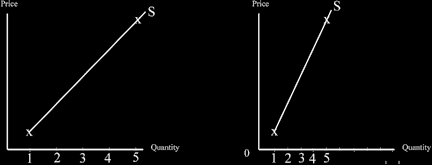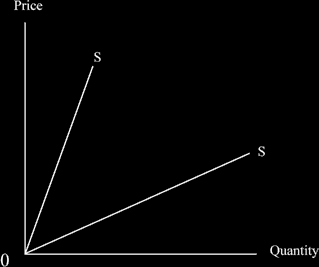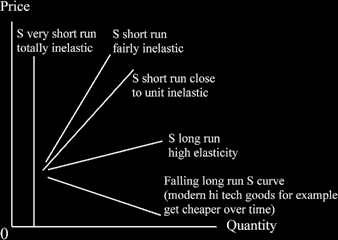| Home | Revision | A-Level | Economics | How Markets Work | The elasticity of supply |
The elasticity of supply
Definition: the responsiveness of the quantity supplied to a small change in price. It is measured by:
%∆Qs / %∆P
The measure roughly indicates the slope of the supply curve; the steeper the more inelastic. Why is this only “roughly”? Because it depends on the scale of the diagram - for instance both the diagrams below have the same elasticity, but because the horizontal scale is not the same the slopes look differ- ent. That is why we have to draw two different elasticities on the same diagram where the scale is the same.

BUT unit elastic supply is any straight line that cuts through the origin! (Just remember this, and do not worry! If you are a mathematician, you may already see why.)

Supply periods and time: (covered briefly earlier)

Very short run = totally inelastic supply = fixed supply (e.g., the amount in a wholesale vegetable market delivered each morning; all the works of dead painters or sculptors).
Short run = perhaps moderately inelastic.
Long run = more elastic; or even negative elasticity (it slopes downward).
Why is supply more elastic in the long run?
Because the company can alter both the fixed and variable factors (i.e., all the factors of production). It can also find new or cheaper sources of raw materials; improve the training of labour; and introduce new technology or better machines. This allows the company to obtain more output without needing much increase in price.
The downward sloping supply curve in the long run is already familiar to you: computers, scanners, TV sets, digital cameras, DVD players and discs, CD players and discs….. Most if not all of the prod- ucts of modern hi-tech industry fall into this category. As the years go by, they get better and a lot cheaper.
Elasticity of supply is probably a bit less interesting to economists than the elasticities of demand - and it is easier to learn as there is less of it!